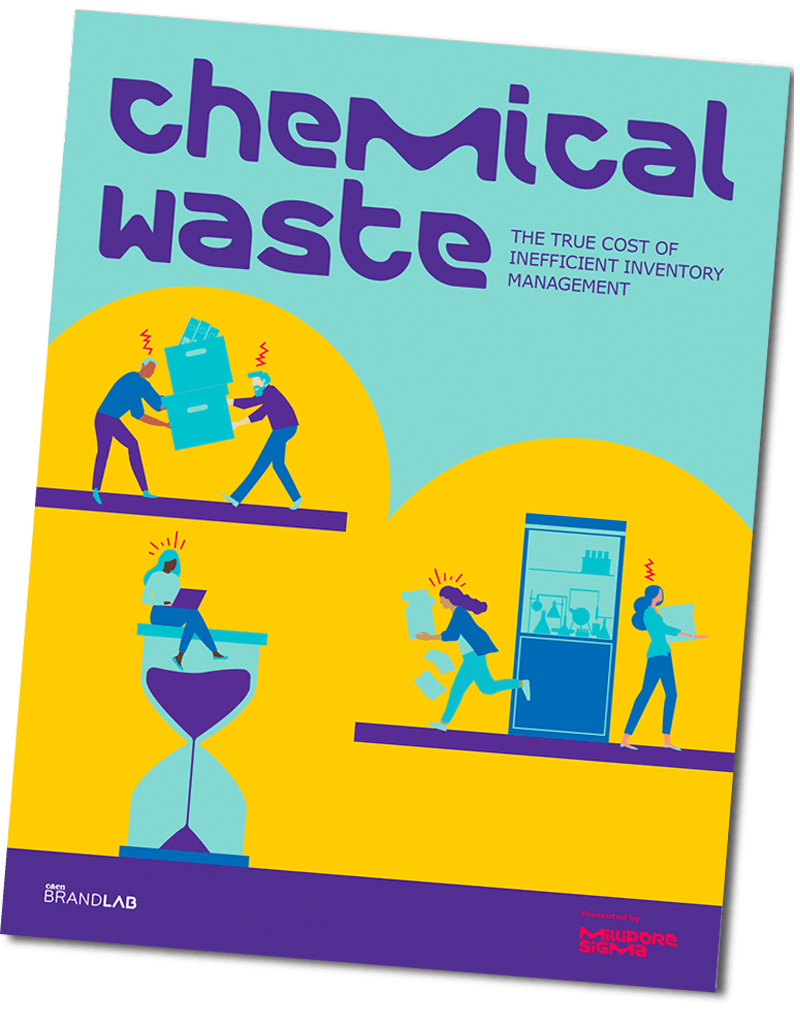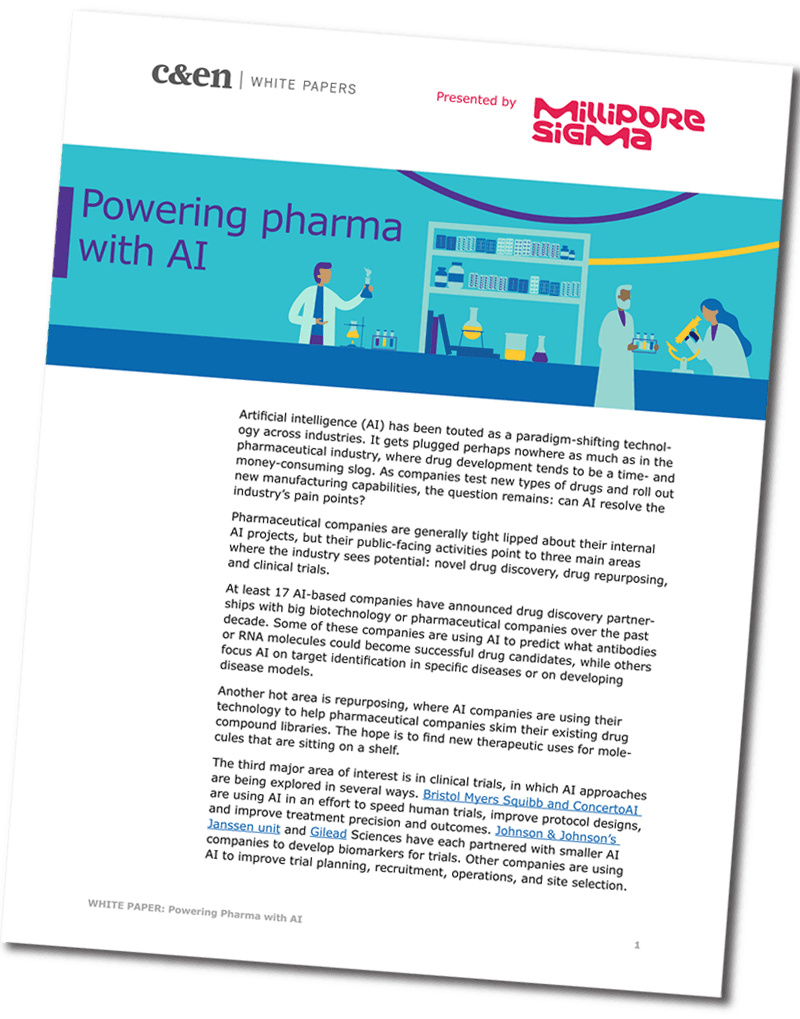Buildingout thedigitallaboratory
Building outthe digitallaboratory
C&EN BrandLab
C live Higgins believes that the life sciences industry is at a crossroads. “They are all desperate to embrace digital technology, and yet they are among the slowest to adopt,” says Higgins, who heads the Connected Lab program at MilliporeSigma. But change is coming, accelerated by the steady ascent of a new generation of tech-savvy lab workers who grew up with the internet and smartphones. In parallel, the far-reaching effects of the pandemic have created the urgent need for research staff to keep their projects up and running while working remotely.
MilliporeSigma launched Connected Lab to develop digital tools that can help facilitate this evolution. Although ensconced within a multinational corporation with over 57,000 employees, Connected Lab operates in a more agile and entrepreneurial fashion to identify innovative opportunities to streamline laboratory operations. Haydn Boehm, head of commercial marketing for Connected Lab at MilliporeSigma, says the goal is to identify “areas that you could optimize the current way of working using a digital product or technology.”
Operating within MilliporeSigma carries a number of critical advantages, including access to an invaluable cohort of beta testers operating at the cutting edge of chemical and biomedical research. “We don’t sell to external companies any product that we wouldn’t use,” says Alessandra Pepe, MilliporeSigma’s technology and innovation lead. “So it’s tested internally, and we run pilot studies and make sure that the software we develop really answers the needs of our labs.”
Connected Lab is focused primarily on two areas: laboratory operations and data management.
Cutting back on chemical waste
On the operations side, MilliporeSigma is tackling the challenge of inventory control. A lab runs on its reagents, and researchers must be able to count on having the chemicals they need when they need them. Tracking the delivery, use, and expiration of research materials can be a daunting task for a small laboratory and quickly becomes overwhelming at a larger commercial organization. Boehm notes that a recent survey revealed that 85% of respondents still use paper or spreadsheet software to track their inventory. “That means the data isn’t real time,” he says. Without a clear sense of what reagents are on-site or where they’re stored, labs may waste money obtaining unnecessary, excess chemicals or allow perfectly useful reagents to expire.
Connected Lab’s LANEXO system makes use of radio-frequency-identification (RFID)-tagged “smart seal” bottle labels to provide the location, expiration status, and use history of every reagent in the lab. This can save time and money by helping researchers find chemicals faster and preventing the purchase of unnecessary, excess chemicals.
Connected Lab’s LANEXO system solves this problem by making use of radio-frequency-identification (RFID)-tagged “smart seal” bottle labels, which can provide both the location and use history of every reagent. “It’s basically the GPS of the lab,” says Annette Hellbach, head of product for Connected Lab at MilliporeSigma. “We have this smartphone application, so you can see while you’re going through the lab that this chemical bottle is in that locker, and so forth.” In addition to avoiding waste, the tool allows scientists to spend more time at the bench and less time meticulously logging reagent usage—a particularly onerous task in highly regulated labs bound by good manufacturing practice (GMP) or other regulations. Some customers have seen time spent on chemical inventory cut by 70–80%, Higgins says.
The information gathered from LANEXO about which chemicals are in storage or active use can in turn be fed into another Connected Lab tool, BrightLab, which provides an integrated system for managing laboratory purchasing. “It’s automatic e-commerce for the restocking of chemicals and materials and consumables,” Higgins says. That spares lab staff the pain of manually monitoring inventory levels and assembling individual online orders by hand. Although BrightLab was devised as a separate software solution, plans are now underway to integrate the two tools into a single, comprehensive materials management platform.
Serving up data solutions
In parallel with systems that help scientists keep experiments running, Connected Lab is developing tools that facilitate data management, analysis, and integration by allowing diverse lab instruments to speak a common language. “Each lab instrument has its own proprietary data format, so all the data that it spits out cannot be read by another piece of software—only the software that the vendor sells with that instrument,” Hellbach says. This is not merely an inconvenience but undermines the ability to archive and compare data sets collected with different instruments; it also confounds efforts to leverage big data techniques such as machine-learning analysis of various experimental data sets. In fact, some older data might become completely inaccessible if a manufacturer discontinues support of the necessary software tools.
Connected Lab’s software offers over 250 converters that convert data from disparate instruments and experiments into a standardized data format. This common language allows researchers to archive and compare data sets collected with different instruments as well as to leverage big data techniques such as machine-learning analysis.
Proprietary data formats and software packages aren’t going away—they remain a core strategy of instrument makers to differentiate their products—so MilliporeSigma has opted to carve out neutral territory where these formats can become interoperable. In the summer of 2019, the company acquired BSSN, a software company that has developed tools for a universal data standard known as Analytical Information Markup Language, or AnIML. “This is the only data standard that’s been approved by the American Society of Testing and Materials,” Boehm says. “AnIML enriches the data with the metadata behind it that I’m going to need to make it more findable, accessible, interoperable, and reusable.” Data in this format are readable by both humans and machines.
BSSN initially facilitated adoption of this data standard by developing a set of software converters that translate proprietary data sets from discrete instrument manufacturers into AnIML. Connected Lab now offers over 250 such converters for different instruments and experiment types, with more on the way. But AnIML also has a thriving open-source community, which is allowing people to freely develop their own converters and adding to the momentum for adoption of the standard. And by serving as a neutral broker for AnIML, MilliporeSigma can promote integration of data from diverse manufacturers without posing a competitive challenge. “Standardizing to one data standard is key to increasing efficiency of lab operations, improving data integrity, and preparing your lab data for any AI applications—basically, it’s the basis for making lab data intelligent,” Hellbach says.
These two streams of product development are only the beginning for Connected Lab. Higgins points out that roughly 90 digital lab initiatives are underway at MilliporeSigma. Most of these are highly focused, such as the organic chemistry tool Synthia (see box). “They’re small ideas for big problems,” he says. But the ultimate vision is to create a more extensive platform in which these tools and other, externally developed software can interoperate seamlessly to more fully streamline laboratory operations and leave the scientists free to do science. “I think we do, for once in our life, really have a chance to change the industry away from the way it’s been working for the last few decades,” Higgins says.
A shortcut to successful synthesis
You’ve identified a promising candidate for your drug program, but because the compound has no prior track record in the literature, you’ll have to design the synthetic process from scratch—or at least that was the case until recently.
Synthia software from MilliporeSigma gives organic chemists an alternative to spending hours combing through reference materials and staring at a whiteboard. “It creates synthetic pathways that are feasible and can be done in the laboratory—not only for known molecules that have been published before, but for absolutely novel drug candidates,” says Ewa Gajewska, chemistry development manager for cheminformatics technologies at MilliporeSigma and one of Synthia’s developers. The company acquired the software in 2017 as part of an effort to build out useful tools for customers who rely on the MilliporeSigma’s extensive chemical catalogue.
The software has been extensively trained in reaction mechanism and factors that might impede synthesis or lead to a suboptimal product. For example, Gajewska says, “Synthia can identify motifs that are prone to side reactions or rearrangements, or that are highly strained and should not be proposed.” The algorithm can also identify the best of multiple possible solutions based on a user’s specific needs, such as the shortest route to a given product or the synthesis that requires the least expensive combination of reagents.
Gajewska notes that the software is especially popular as a tool for fine-tuning synthetic protocols. And as laboratory automation continues to mature and become more mainstream, she envisions the potential to couple software like Synthia to robotics for the rapid design, testing, and optimization of synthetic processes with only limited intervention by users. “I think that this will be a direction for the future,” Gajewska says.




